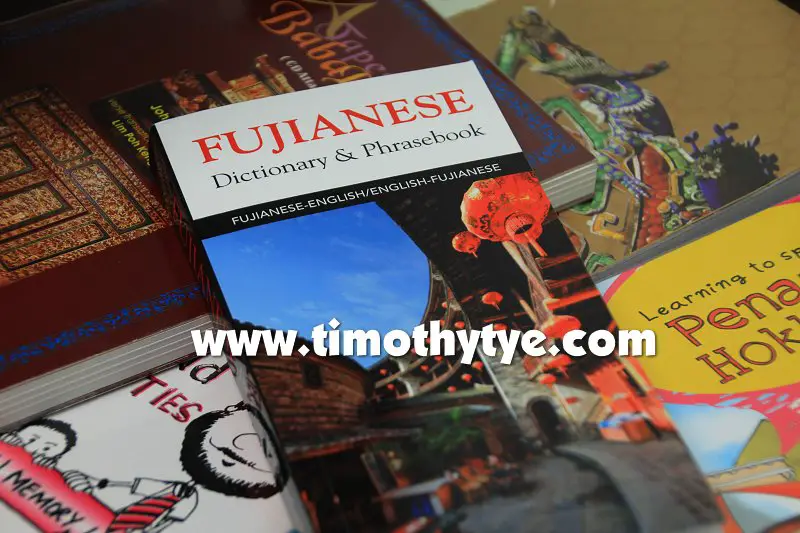
Fujianese Dictionary & Phrasebook (13 March, 2014)
© Timothy Tye using this photo
After some five months of waiting, the Fujianese Dictionary & Phrasebook finally landed on
My Little Bookshelf. I ordered it out of curiosity. The book, published by Hippocrene Books in New York, was supposed to have been delivered four months ago, but the publishing got delayed. Well finally I can put my curiosity to rest.
At the top of the heap is the word "Fujianese" itself. What does the book mean when it calls itself a Fujianese Dictionary? After searching about for a non-existent intro, I found the explanation in the blurb on the backcover, and as soon as I read it, I was disappointed. As I had feared, this dictionary attempts to kill all birds with one stone. It is attempting to be a dictionary of the Min group of Chinese languages, and I think it is being too ambitious.
The first sentence of the blurb says it all: "Fujianese is spoken by more than 47 million people, mainly in China and Taiwan." Really? Do that many people speak "Fujianese" today? Even in Fujian Province itself, I believe the majority of the people speak Mandarin nowadays. In any case, the figure given by it is more conservative compared to the 60 million
1 provided by Wikipedia.
Going down the blurb, I read that "Fujianese (or Hokkien) is a part of the Min Nan family of Chinese dialects." I am so confused. If I read that sentence right, this book is telling me that Fujianese is a subset of Min Nan - then what's in Min Nan that's not Fujianese?
Having disputed the backcover blurb, I flipped the book over, and now I have a problem with the cover photograph. It shows a
tulou, or Fujian earth house. The problem here is that, although
tulous are found in Fujian Province, they are a Hakka architecture, and the Hakka language is in a different language group from Fujianese (whatever that means) or Min Nan, or even the whole Min group.
Aiyoo, this is so misleading leh!
Now I open the book. If the covers haven't annoyed me sufficiently, the content completes the job.
The pronunciation guide uses a "pseudo IPA" system, with a dash of Wade-Giles thrown in for good measure. It claims there are 15 consonants in Fujianese, namely p, p', m, t, t', N, L, ts, ts', s, k, k', ŋ, h and ø. The examples it provides for the sound of these 15 consonants left me stranded. For p, it offers "pie", but for p', it offers "pay". What's the difference between the p in pie and pay, I do not know. I suppose it is trying to explain the aspirated sound, but "pay" is a poor example.
In the vowel section, I dispute that the "a" in s
ad is pronounced ɔ in IPA, or the "a" in f
ar is pronounced ɛ. As for glottal stop, the example for ʔ is the "t" in fa
t.
The dictionary follows the 7-tone system used by many romanised Hokkien dictionaries. However, instead of diacritics, it uses tone numbers, "similar" to my TJ system. What annoys me here is that it doesn't explain what's dark-level, middle rising and falling, etc., etc. The dictionary continues by stating, "For words without tone numbers, this tone is also known as the neutral tone. There is no symbol over the vowel ..." I wanted to say, excuse me, what do you mean
symbol over the vowel; your dictionary isn't using diacritics, so there aren't any symbols over any vowels!
Next comes the section on Basic Grammar, and here, this book makes me wish my room has a window (for if it does, I want to toss this book out, and hard). Listen: "Fujianese grammar is essentially similar to the grammar of Mandarin. Those who know the grammatical structure of written Chinese will only need to focus on the Fuzhou dialect pronunciation." I wanted to say, huh? Fuzhou? It's still fresh in my memory that the backcover blurb stated that Fujianese is a part of the Min Nan family, but Fuzhou is not within the Min Nan family, so what are you telling me? I think the authors themselves cannot differentiate Min Nan from Min Dong.
The dictionary has both a Fujianese-English as well as a English-Fujianese section. However, I can't use the Fujianese-English section, even if I have a word to look up. It doesn't explain how the words are arranged. Does it expect me to go through the hundreds of Chinese characters it lists, with the good fortune that I find one that matches the one I am searching?
The English-Fujianese section is easier to use, as here the entries are in alphabetical order. But checking on a few entries confirm to me that this Fujianese language is a strange beast, probably an amalgamation of words from several different Southern and Eastern Min dialects. For example, the entry for snake (蛇) is not tsôa or cua2, it's sie2. The number 17 is sɛi7 løy7.
This book also has a phrasebook, with a section devoted to phrases in Fujianese, but after what I have seen, I am quite done. I do not know which part of Fujian Province I can use this book and be intelligible. I usually review books with the intention of recommending it to other readers, but in this case, I am reviewing the Fujianese Dictionary & Phrasebook with the intention of not recommending it to anyone, save those wishing to humor themselves.
Details
Title: Fujianese Dictionary & Phrasebook
Author: Xiao Chu Chen (translator)
ISBN: 10: 0-7818-1313-1
Publisher: Hippocrene Books, Inc.
Year of First Publication: 2014
References
- Min Chinese: http://en.wikipedia.org/wiki/Min_Chinese
Copyright © 2003-2022
Timothy Tye. All Rights Reserved.

